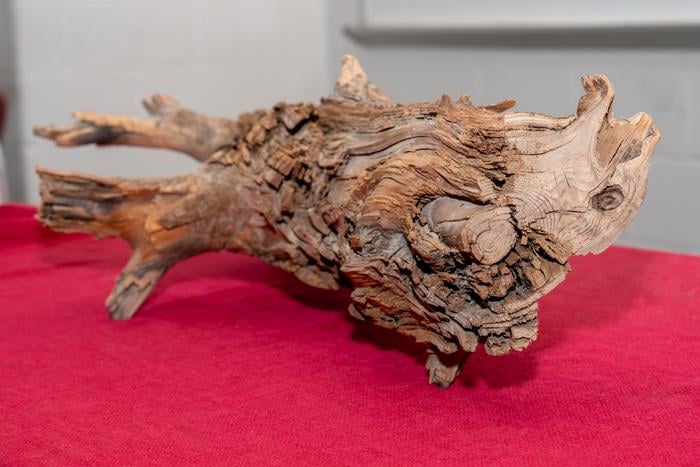A 3,775-year-old log unearthed in Quebec, Canada, has remained remarkably well-preserved, losing less than 5% of its original carbon content. This discovery, detailed in a new study published in the journal Science, offers compelling evidence for the potential of “wood vaulting” as an effective method to combat climate change.
Summary: Researchers have found that burying wood in specific soil conditions can prevent decomposition for thousands of years, potentially offering a low-cost solution for long-term carbon sequestration.
Estimated reading time: 5 minutes
In a groundbreaking study led by University of Maryland Atmospheric and Oceanic Science Professor Ning Zeng, researchers analyzed an ancient Eastern red cedar log and its surrounding soil, uncovering key insights into preserving wood and, by extension, capturing carbon dioxide for millennia.
The log, excavated from a depth of about 6.5 feet, was found to be in exceptionally good condition. “The wood is nice and solid—you could probably make a piece of furniture out of it,” Zeng noted.
This chance discovery occurred during a wood vaulting pilot project in Quebec in 2013. Wood vaulting involves burying non-commercially viable wood, such as trees destroyed by disease or wildfires, old furniture, or unused construction materials, to prevent decomposition and subsequent release of carbon dioxide into the atmosphere.
The Science Behind Wood Preservation
The study, published on September 27, 2024, reveals that the key to the log’s preservation lies in the surrounding soil conditions. The low-permeability clay soil in which the log was buried effectively sealed it off from oxygen, fungi, and insects—the primary agents of decomposition.
Researchers compared the ancient log’s microscopic structure, chemical composition, mechanical strength, and density to that of a freshly cut Eastern red cedar. The results were striking, showing that the 3,775-year-old sample had lost very little carbon dioxide over its long burial.
Implications for Climate Change Mitigation
Trees naturally sequester carbon dioxide during their lifetime, making them a popular focus for climate change mitigation efforts. However, when trees die and decompose, they release this stored greenhouse gas back into the atmosphere.
Wood vaulting offers a potential solution to this problem by preserving wood long after a tree’s natural life cycle has ended. Professor Zeng explains the significance: “People tend to think, ‘Who doesn’t know how to dig a hole and bury some wood?’ But think about how many wooden coffins were buried in human history. How many of them survived? For a timescale of hundreds or thousands of years, we need the right conditions.”
The study suggests that wood vaulting could become a viable and low-cost option in many parts of the world, given the prevalence of clay soil. However, Zeng emphasizes that this method should be used in conjunction with other strategies to combat global warming, including reducing greenhouse gas emissions.
Future Prospects and Challenges
While the discovery is promising, implementing wood vaulting on a large scale will require careful planning and further research. The study estimates a global sequestration potential of up to 10 gigatonnes of CO2 per year using existing technology, at a relatively low cost of $30 to $100 per tonne after optimization.
“It’s quite an exciting discovery,” Zeng said. “The urgency of climate change has become such a prominent issue, so there was even more motivation to get this analysis going.”
As researchers continue to refine wood vaulting techniques, this ancient log serves as a testament to the potential of this innovative approach in our ongoing battle against climate change.
Quiz
- How old is the log discovered in Quebec?
- What type of soil was crucial for preserving the ancient log?
- What is the estimated global sequestration potential of wood vaulting per year?
Answers:
- 3,775 years old
- Low-permeability clay soil
- Up to 10 gigatonnes of CO2 per year
Further Reading
Glossary of Terms
- Wood vaulting: A climate solution involving the burial of non-commercially viable wood to prevent decomposition and carbon dioxide release.
- Carbon sequestration: The process of capturing and storing atmospheric carbon dioxide to mitigate climate change.
- Permeability: The ability of a substance to allow liquids or gases to pass through it.
- Anoxic environment: An environment lacking oxygen, which can inhibit decomposition processes.
- Gigatonne: A unit of mass equal to one billion metric tons, often used in measuring large-scale carbon emissions or sequestration.
Enjoy this story? Get our newsletter! https://scienceblog.substack.com
If our reporting has informed or inspired you, please consider making a donation. Every contribution, no matter the size, empowers us to continue delivering accurate, engaging, and trustworthy science and medical news. Independent journalism requires time, effort, and resources—your support ensures we can keep uncovering the stories that matter most to you.
Join us in making knowledge accessible and impactful. Thank you for standing with us!

